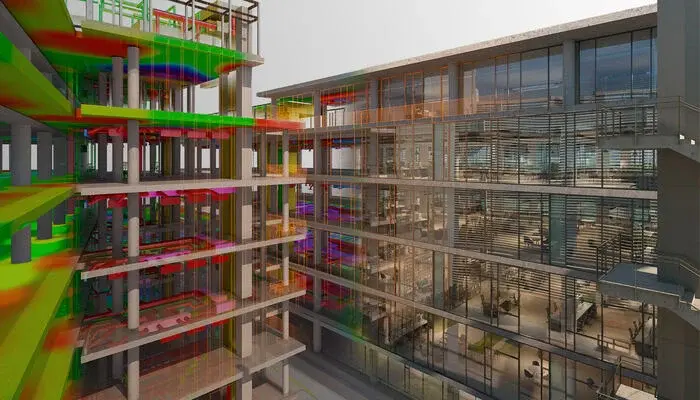
If you’re a structural modeler who spends hours perfecting steel connections or reinforcement details in Tekla, you’ve already mastered one of the most powerful modeling tools in the AEC industry.
But the industry is changing fast.
Today, global construction projects are no longer executed in silos. They demand seamless coordination across multiple disciplines architecture, engineering and construction and all tied together through Building Information Modeling (BIM).
This shift has created new, high-paying roles like BIM Engineer, which require professionals who can think beyond modeling and take charge of end-to-end coordination and data-driven project delivery.
So, how can a Tekla Modeler make this transition successfully? Let’s break it down step by step.
What Differentiates a BIM Engineer from a Tekla Modeler in Real Project Workflows?
At first glance, both roles may appear similar. Both create models and contribute to digital construction workflows. But the difference lies in scope and strategic impact.
A Tekla Modeler focuses mainly on structural detailing including steel connections, rebar modeling, or preparing fabrication drawings. The role is highly technical, but also narrow in scope. Your work is critical but often limited to the structural domain.
A BIM Engineer, however, takes a multidisciplinary approach. Instead of only focusing on how the structure is built, they consider how the entire project comes together including structure, architecture, and MEP ensuring all models align perfectly.
Here’s how these roles differ in day-to-day project workflows:
|
Aspect |
Tekla Modeler |
BIM Engineer |
|
Primary Focus |
Structural modeling and detailing |
Coordination across multiple disciplines |
|
Tools Used |
Tekla Structures |
Tekla + Revit + Navisworks + BIM 360 |
|
Output |
Shop drawings, fabrication models |
Federated models, clash-free deliverables |
|
Collaboration |
Works within structural team |
Works with architects, MEP, and project managers |
|
Mindset |
Technical execution |
Strategic coordination and problem-solving |
In short:
“A Tekla Modeler is technical. A BIM Engineer is multidisciplinary and strategic.”
Major Skill Gaps Between a Tekla Modeler and a BIM Engineer
Understanding the gaps is the first step in closing them.
1. Multidisciplinary Awareness
As a Tekla Modeler, you may have deep structural knowledge but BIM Engineers need to understand how their work impacts architectural and MEP systems. For example, a beam modelled in Tekla must not clash with ductwork designed in Revit MEP.
2. Coordination Knowledge
BIM Engineers manage model federation, clash detection, and information exchange between teams. This means you must be familiar with file formats (IFC, NWC, RVT), naming conventions, and LOD (Level of Development) standards.
3. Communication & Collaboration Skills
Structural professionals often work independently, but in BIM workflows, being a “lone wolf” doesn’t work. You must learn to communicate design intent clearly, lead coordination meetings, and collaborate with diverse teams.
4. Problem-Solving Mindset
As our industry guide emphasized:
Every time I talk about BIM, I talk about solving problems rather than knowing everything.
BIM is not about mastering every tool, but about finding the right solution when challenges arise whether it’s interoperability, design conflicts, or data errors.
5. Project Understanding
BIM Engineers must think about project scheduling, sequencing, and data flow — areas that Tekla Modelers rarely engage with. Understanding these dimensions helps bridge the technical-to-managerial gap.
What Additional Tools Should a Tekla Modeler Learn to Facilitate a Smooth Transition?
The key to becoming a BIM Engineer is expanding your toolkit beyond Tekla. While Tekla remains essential for structural modeling, a BIM Engineer must manage multi-software environments.
Here are the most valuable tools to learn:
1. Navisworks Manage
The go-to tool for clash detection and model federation. Allows you to integrate models from Tekla, Revit, and other platforms to identify conflicts before construction begins.
2. Revit (Basics)
Even a basic understanding of Revit can help you interpret architectural and MEP models — essential for effective coordination.
3. BIM 360 / Autodesk Construction Cloud
For cloud-based collaboration, issue tracking, and model version management. Most international projects today use these platforms for BIM coordination.
4. Solibri or BIMCollab
Great for quality checks, compliance reviews, and ensuring your models meet project standards.
5. Dynamo or Grasshopper (Optional)
For automation in repetitive modeling or data extraction tasks. Adds value if you want to move toward computational BIM workflows later.
6. Plannerly or BIM Execution Planning Tools
To understand and apply ISO 19650 standards which is crucial for working on global BIM projects. In essence, learning Navisworks + Revit basics on top of Tekla is the fastest and most impactful way to transition.
Certification or Training Recommendations for Structural BIM Workflows
If you’re looking for cost-effective ways to upskill, several free or low-cost certifications can give your BIM journey a strong start:
- Novatr's BIM Professional Course For Civil Engineers – Helping structural engineers understand multidisciplinary BIM workflows.
- Autodesk Learn Hub – Offers free learning paths on Navisworks, Revit, and BIM fundamentals.
- Tekla User Assistance (Trimble) – Free tutorials and certification tests for Tekla Structures.
- Plannerly Academy (ISO 19650 Introduction) – Learn the foundations of BIM standards and documentation.
- buildingSMART OpenBIM Basics – A globally recognized free course introducing OpenBIM concepts.
These certifications don’t just boost your resume. They demonstrate your willingness to evolve beyond a single-discipline skill set.
Expected Salary Jump When You Transition to a BIM Engineer
Transitioning from a Tekla Modeler to a BIM Engineer often comes with a significant salary boost.
Based on industry insights, the average salary increase ranges from 30–50%, with optimistic scenarios reaching 70% depending on project type, company scale, and location. Even conservative cases show a 15–25% hike.
For example:
If a Tekla Modeler earns around ₹6–8 LPA, a BIM Engineer with coordination skills and multidisciplinary exposure can easily earn ₹10–12 LPA or more.
The main factors influencing your salary include:
- The complexity and size of projects you’ve handled
- The number of tools you’re proficient in
- Your experience with ISO/BEP standards
- Your ability to communicate across disciplines
In global contexts like the Middle East, Singapore, and the U.S., the salary jump is even higher due to the demand for skilled structural BIM professionals.
Is It Possible to Transition to a BIM Engineer by Enrolling with Novatr?
Absolutely.
Novatr’s BIM Professional Course for Civil Engineers is built precisely for professionals like Tekla Modelers who want to step into multidisciplinary BIM roles.
Through hands-on projects, exposure to real AEC workflows, and mentorship from industry experts, learners gain practical experience in:
- 5+ industry softwares, including Autodesk Revit, Navisworks, Autodesk Construction Cloud: Docs, Coordination & Collaboration.
- Mastery of essential plugins such as EF-Tools, DiRoots.One, pyRevit, ProSheets, Issue and Model Checker for Revit to automate documentation and improve precision.
- Learn complete BIM workflows — from digital design development, estimation & BOQ, and information modeling to clash detection, sequencing, and multidisciplinary coordination.
- Get hands-on experience working on real commercial and residential projects following ISO 19650 standards, guided by mentors from the global AEC industry.
- Develop professional construction documentation, audits, and deliverables aligned with international BIM practices.
Earn globally recognized certifications:
- Novatr Course Certificate, signed by the Academic Director.
- Autodesk User Certification, validating your command over Autodesk tools.
- NSDC Certificate, officially recognizing your BIM expertise.
- Optional Specialization Certificates, for learners who wish to deepen their skills in niche BIM applications.
Go Further with Optional Post-Program Specializations:
After completing the core BIM program, learners can choose to add any two specializations to refine their expertise in advanced BIM workflows and tools. These add-on modules let you tailor your learning path based on your career goals and project interests.
Available specializations include:
- Visual Programming with Dynamo – Automate repetitive modeling tasks and customize Revit workflows through parametric scripting.
- 4D, 5D & 6D with BIM – Integrate time, cost, and sustainability data into your BIM models for end-to-end project management.
- Design Development with Autodesk Forma – Explore conceptual design and site analysis with cloud-based environmental data.
- Project Strategy & Optimization with Plannerly – Plan, structure, and audit BIM execution plans with real-world project strategies.
- BIM for Infrastructure with Civil 3D – Model, simulate, and analyze roads, bridges, and other civil infrastructure projects.
- Prefabrication & RCC Modeling with Tekla – Design and coordinate reinforced concrete and steel structures for constructability.
- Visualising Landscape with Enscape – Create immersive real-time visualizations for landscape and site design presentations.
- Interior Detailing & Visual Storytelling with Twinmotion – Transform architectural and interior BIM models into photorealistic, story-driven visuals.
These optional specializations provide an in-depth understanding of how different software and workflows enhance project performance, sustainability, and design visualization making you a more versatile BIM professional.
However, beyond enrolling in a course, professionals should also focus on building soft skills especially problem-solving, leadership, and stakeholder communication.
With Novatr’s guidance and continuous self-learning, a structural modeler can confidently transition into a BIM Engineer role and prepare for future progression into BIM Coordinator or BIM Manager positions.
Conclusion
Transitioning from a Tekla Modeler to a BIM Engineer is not about abandoning your technical strengths. It’s about amplifying them through multidisciplinary understanding and coordination expertise.
By mastering additional tools like Navisworks and Revit, gaining exposure to ISO-based workflows, and embracing a collaborative mindset, you can position yourself at the forefront of modern digital construction.
In an industry that rewards those who can connect the dots between disciplines, BIM Engineers are not just better paid but they’re the professionals shaping the future of how buildings are designed and constructed.
So, if you’re ready to move beyond modeling and start managing, the path is clear upskill, coordinate, and lead your way into the BIM future.
BIM Professional Course for Civil Engineers by Novatr is the perfect opportunity to gain in-depth knowledge and hands-on experience in BIM workflows.
For the latest updates and insights, visit Novatr's Resource Page.
Stay ahead in your career and apply for this course today!
Was this content helpful to you



.jpg)




